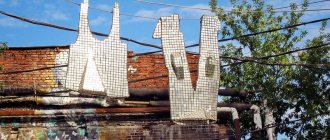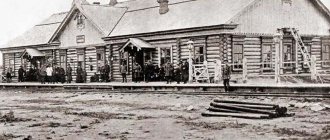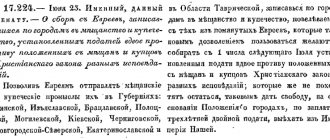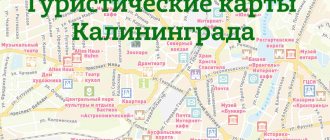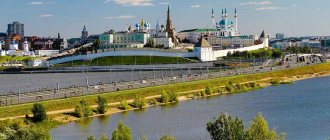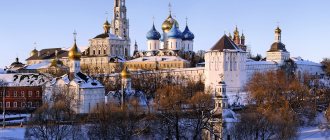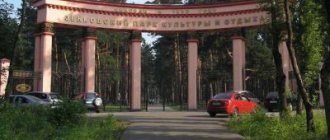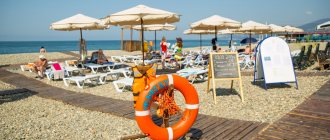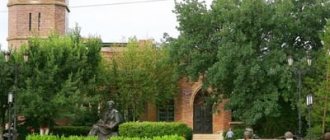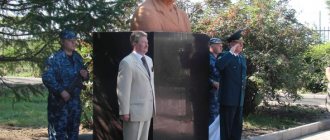Kaliningrad is called a city with a European spirit and Russian soul. The city is located in the westernmost part of Russia and is separated from the rest of the country by the territory of Poland, Lithuania and Belarus. Before the Great Victory in 1945, it belonged to Prussia and was called Königsberg. Kaliningrad attracts tourists with its ancient German architecture, green parks, modern museums and funny sculptures. We have compiled a list of 15 must-see attractions in the city.
Fishing village
The complex of buildings in the old German style, built in 2005 on the embankment of the Pregolya River, is called “little Europe”. The best postcard views in Kaliningrad open here. There are several restaurants overlooking the river, three hotels, souvenir shops and a lighthouse with an observation deck from where you can take panoramic photos. The tents sell mulled wine and pastries, and sell amber souvenirs. River boats depart regularly from the Pregolya pier - ideal for a romantic walk. Opposite the Fishing Village is Kant Island, where the Kaliningrad Cathedral is located.
Fishing village, Kaliningrad
Address:
st. Oktyabrskaya, 2-8, Kaliningrad.
Cathedral
The 14th century Gothic church is one of the main symbols of Kaliningrad. In pre-war times it had the status of the main cathedral of East Prussia. The temple was badly damaged during the bombing of World War II, but was restored. Currently, services are not held here; the cathedral operates as a museum and concert complex. The building houses the Kant Museum, a concert hall, Catholic and Orthodox chapels. Near the wall of the cathedral is the grave of the great German thinker, professor at the University of Königsberg, Immanuel Kant.
Cathedral, Kaliningrad
The cathedral's concert hall hosts about 700 classical music concerts every year, including those using the organ. The cathedral's organ complex is the largest in Russia. It consists of the Large and Small Organs, which have a total of more than 8.5 thousand pipes. The complex is simultaneously managed by two organists. Organ concerts are very popular, so tickets must be purchased in advance. To explore the decoration of the church and see the organ complex, you need to attend a concert or buy a tour.
Kant's grave, Kaliningrad
Address:
st. Kanta, 1, Kaliningrad.
Operating mode:
daily from 10:00 to 19:00.
The first day. Walking around the city
If this is your first time in Kaliningrad, we recommend walking for the entire first day - walking along traditional tourist routes in the center, looking at the architecture, monuments and popular corners of the city.
Usually, an acquaintance with the city begins in the Fish Village - a tourist quarter on the banks of the Pregolya River, built in 2007 in the style of an ancient half-timbered building. There is a tourist information center, hotels, popular restaurants and an observation tower in the shape of an old lighthouse. This part of the embankment is connected to other areas by pedestrian bridges, one of them - the Honey Bridge - leads to Kant Island .
Fishing village Photo: © Tatyana Kvichanskaya
The old name of the island is Kneiphof; in Prussian times it was an urban area with dense buildings, whose inhabitants were engaged in trade, crafts and shipping. In the Middle Ages, the settlement on the island of Kneiphof had the status of an independent city, which was connected to the neighboring areas of Altstadt and Löbenicht by five bridges. As a result of the bombing of 1944, the buildings on the island were severely destroyed, and subsequently dismantled into bricks and taken to Leningrad for restoration work. Only the badly damaged building of the Königsberg Cathedral , built in the 20th century, has survived. In 1998, the temple was restored, and a magnificent example of the “Northern Brick Gothic” architectural style became the hallmark and symbol of Kaliningrad.
Koenigsberg Cathedral Photo: © Anna Kudryavtseva
Currently, the cathedral is used as an organ concert hall; it houses the largest complex of large and small organs in Russia. Organists from many countries around the world come to festivals and concerts in the hall of the Cathedral. During the daytime, daily organ mini-concerts are held for listeners; their schedule, as well as the cathedral’s tour poster, can be viewed on the official website.
DetailsPoster of the Cathedral
The cathedral is also famous for the Immanuel Kant Museum and his memorial burial. The biography of the outstanding philosopher is connected with Königsberg and the Albertina University of Königsberg, where the founder of German classical philosophy worked as a professor. You can walk around the island around the cathedral in the Sculpture Park , created from the works of Soviet sculptors of the second half of the twentieth century.
Sculpture Park Photo: © Anna Kudryavtseva
After leaving Kneiphof Island, along one of the central streets of Kaliningrad, Leninsky Prospekt, you can walk to Victory Square. The road will pass through the Central Square, famous for two painful points on the city map - the foundation of the Royal Castle and the giant “abandoned” building - the House of Soviets . The chronicled history of the castle began in 1257, when the construction of a stone fortress began on the lands of the Prussians, captured by the Teutonic knights, under the leadership of the Grand Master of the Teutonic Order, Peppo von Ostern. Over the centuries, Königsberg Castle has survived many sieges; the coronations of the kings of Prussia, Frederick Ⅰ and Wilhelm Ⅰ, were held there. The history of the castle has pages connected with Russia. The royal residence hosted the embassies of Vasily II and Peter the Great. In 1697, in honor of Peter the Great’s “Great Embassy,” the large reception hall in Königsberg Castle was even renamed the Muscovite Hall.
Royal Castle of Koenigsberg Photo: ©
The history of the castle in Soviet times is sad; after military bombing, it stood in a dilapidated state until the end of the 1960s and was gradually torn down into bricks. The remains of the walls were blown up in 1967, and in their place, in the area of the castle moat, the House of Soviets was built. The building in the monumental Soviet style was intended to house the highest party and executive bodies of the Kaliningrad region. The facility, 95% complete, was frozen in 1988; since then it has not been used, and to this day the question of its demolition has not been closed. Over the years, the concrete box, erected on 1,148 concrete piles and a strong reinforced concrete frame, has remained almost unchanged and appears on tourist photographs as a monument to the architecture of “Soviet brutalism” and an example of the destruction of valuable historical objects in favor of the architectural dominants of the communist regime.
House of Soviets Photo: © DK1974
Victory Square , the former trading square of Koenigsberg (Hanseic), the place where many administrative and commercial facilities of Kaliningrad are concentrated. After large-scale work on the occasion of the 750th anniversary of the city, the square acquired a modern look. A Triumphal Column , crowned with an image of the Order of Victory, was installed in the center Cathedral of Christ the Savior and the Chapel of Saints Peter and Fevronia . The architecture of these temple buildings can be seen in the so-called pseudo-Russian style, imitating the ancient Vladimir-Suzdal church architecture.
Temple complex on Victory Square Photo: © Anna Kudryavtseva
The area around Victory Square is famous among tourists; they have created a tradition of making an evening tour of local brewpubs and consistently tasting craft varieties of Kaliningrad beer. The most popular establishments are “Kropotkin” , “Khmel” , “Aunt Fisher” and others, where you can finish the first day of your trip. For a non-alcoholic evening scenario, it’s worth returning to the embankment in Rybnaya Village, where pleasure boats depart from its pier on the Pregola River for evening excursions. From the water you can see beautiful panoramas of the evening city; you can admire the ships at the Historical Fleet Embankment , the Kaliningrad port , views of the Kneiphof Island and the spectacularly illuminated Cathedral.
Panorama of Kaliningrad Photo: © Valentina Pushkareva
Leninsky Prospekt
This is the main street of the city, along which there are many shops, souvenir shops, popular cafes and bars.
The avenue starts from Victory Square and stretches 3 km. Many excursions around the city and to the Curonian Spit start from here. During the Great Patriotic War, buildings in the city center were destroyed, so there are practically no architectural monuments on the avenue. For the World Cup, local Khrushchev buildings were renovated and turned into multi-colored “gingerbread” houses in the Hanseatic style - quite a nice stylization of Europe. If you take a photo with them in the background, you can even convince your friends that you have been abroad. At the beginning of Leninsky Prospekt there is the Europe Center shopping center, popular among citizens, and in front of it there is a small square with the Mother Russia statue, near which meetings are often scheduled. Leninsky Prospekt, Kaliningrad
The main attractions of Kaliningrad: names, descriptions, photos
The main attractions of Kaliningrad with photos, videos, descriptions and maps: gates and forts, museums, temples, parks, German quarters, new top places and the best routes in the surrounding area. The review below will help you figure out what to see in Kaliningrad on your own first.
Kaliningrad and the region attract tourists with its special location, the combination of Russian and European, and the ambiance of a city in the Baltic region.
To see Kaliningrad on your own, you should definitely include the island of Kneiphof and go around its surroundings, at the same time remembering and trying to solve Euler’s riddle about the seven Konigsberg bridges (spoiler - not all of them survived, but there is a visual image of the riddle among the city’s art) and find the ruins of the Konigsberg castle _ The best first route around Kaliningrad with sightseeing is circular. Thus, even in a day you will be able to see all the surviving city gates of Kaliningrad and, at the same time, see almost all the main attractions of the city center.
Of course, it’s difficult to get around museums in one or even two days. And it is advisable to plan your visit in advance, checking the opening hours.
More details: Museums of Kaliningrad
temples in the city are also interesting . And we are talking not only about the Cathedral , the most recognizable symbol of Kaliningrad, but also the Cathedral of the Exaltation of the Cross (the former Kreuzkirche), the Church of the Intercession of the Blessed Virgin Mary (the former Rosenau Church), distinguished by a clock tower and lancet windows, as well as lesser-known churches, the buildings of which are now are no longer used for their intended purpose.
The cultural life in the city is rich and varied. Kaliningrad theaters are preparing premieres and showing classics.
In city parks, not only active recreation or relaxation after many kilometers of walks with an overview of top places is possible. There are also attractions in the park areas: these are memorials, museums, a Ferris wheel, and viewing platforms near the coast.
For a trip with children, we recommend looking at the most detailed overview of entertainment, master classes, quests and other sites:
Where to go and what to see with children in Kaliningrad
In the vicinity of Kaliningrad, if you do not consider trips to authentic cities of the region and the Curonian Spit National Park , the most attractive and feasible is a thematic route with an overview of the forts of Kaliningrad - especially for tourists interested in military history. The condition of the fort-monuments varies: some are abandoned or inaccessible, others are museums with interesting exhibitions.
In detail: Forts of Kaliningrad
Square of victory
This is the central square of Kaliningrad.
At the time when Königsberg was part of the Hanseatic League, it was called Hansa Platz, and when Hitler came to power it bore his name. After the war and the transition of Königsberg, the USSR was named in honor of the Victory. The city administration is located on the square, and in front of it stands the Triumphal Column in honor of the Great Victory. To the side of Victory Square stands the snow-white Cathedral of Christ the Savior. It was erected in the traditions of Vladimir-Suzdal architecture in 2009. When laying the church, they used a capsule with soil from under the Cathedral of Christ the Savior in Moscow. The temple can accommodate 3 thousand people. Also near the square are the Clover City shopping center and the Kaliningradsky Passage shopping center. Behind the Passage is the Northern Station - the second most important railway station in Kaliningrad, from which you can go to Svetlogorsk and Zelenogradsk. Cathedral of Christ the Savior, Kaliningrad
What is remarkable about Kaliningrad and why do people go there on vacation?
Kaliningrad ranks first among popular tourist cities in Russia; we met Poles and even Chinese on its streets. Who is the former Prussian Koenigsberg, and now an enclave, fenced on all sides by Europe and not having land borders with Russia?
It became ours relatively recently, in 1945, that is, after the end of the war, before the partition it was officially the capital of East Prussia. Thanks to its foreign origin, historical architectural buildings remain on its streets, and if you do not have a Schengen visa, only in Kaliningrad you can see with your own eyes the former heritage from previous owners - residences of kings, medieval forts, and instead of churches, visit Gothic churches. In contrast to the broken down Khrushchev houses and noble estates of the prosperous Amalienau region, it is clearly visible here how the Russian spirit coexists with the Prussian one.
In addition to castles, Kaliningrad has perfectly preserved Soviet buildings in a recognizable Stalinist style, the most famous of which is the unfinished House of Soviets, and the premises of Soviet clubs are successfully used while preserving the past appearance.
It’s nice to look at buildings restored without fanaticism, and paving stones are just a separate type of pleasure.
The city received a new name in honor of party leader Mikhail Kalinin, whose monument is located on the square of the railway station.
You can say about the weather in Kaliningrad in one phrase - “If you don’t like the Kaliningrad weather, wait ten minutes.” We were here at the end of September and we never needed the umbrella we brought.
Museum of the World Ocean
The museum complex is dedicated to the inexhaustible riches of the world's oceans.
The complex includes the main building and separate museum ships on the Pregolya embankment, as well as branches in different parts of the city. A submarine, a fishing trawler, a seaplane, a space communications vessel - it’s worth spending a whole day to inspect all the vessels. Be sure to visit the legendary research ship "Vityaz", on which scientists from different countries studied the ocean for many years. It was from it that the depth of the Mariana Trench was first measured. Today there is a museum on the ship and a boat is open - you can spend the night in the cabins in which members of scientific expeditions lived. World Ocean Museum ship
The main building of the museum complex houses aquariums with marine life, the Mir-1 deep-sea submersible and the skeleton of a sperm whale, one of the largest in Russia. Nearby, a new building of the Planet Ocean museum in the form of a large glass ball is being built. One of the branches of the museum, the Maritime Exhibition Center, is located in Svetlogorsk. It contains an ethnographic collection dedicated to the people of the sea, and also has a gallery of artistic works on a maritime theme.
Address:
Peter the Great embankment, 1, Kaliningrad.
Operating mode:
main building - every day from 10:00 to 18:00, closed on Mondays.
Amber Museum
The country's only amber museum is located in the Don Tower of the Königsberg Fort.
The exhibition consists of several parts and is located on three floors. The natural science department has collected various amber samples - pieces of fossilized resin with insects and plants aged 45-50 million years. Among them is the largest sun stone in Russia and the second largest in the world, weighing 4 kg 280 g. It was found in the village of Yantarny, where the Kaliningrad Amber Factory is located. Amber Museum, Kaliningrad
Another exhibition presents products made from Baltic gemstones: sculptures, interior items, icons, portraits, boxes, cups, jewelry. Notable is the Faberge cigarette case made of amber, made in 1913. Some exhibits are elaborate copies of original masterpieces, for example, fragments of the lost Amber Room. Among them is the world’s largest mosaic painting made of amber - the decorative panel “Rus”. On the ground floor of the tower there is an exhibition of amber products by contemporary authors.
To learn more about the extraction and industrial processing of amber, it is worth going to the village of Yantarny to the amber factory. Here you can see the quarry where sunstone is mined and find your own piece of resin in the sand.
Address:
pl. Marshala Vasilevsky, 1., Kaliningrad
Operating mode:
May - September - from 10:00 to 19:00, seven days a week, October - April - from 10:00 to 18:00, Monday - closed.
Day four. Königsberg Fortress
We recommend spending the fourth day in Kaliningrad again and devoting it to getting to know the defensive system of the fortified city of Koenigsberg. The first fortifications appeared here in the 20th century, when ramparts were poured, ditches were dug and stone walls with gates were built. Over the centuries, the defense system was constantly improved, ravelins were built, and in the 20th century, the Friedrichsburg Fortress was built to cover the city from the sea, of which only the Friedrichsburg Gate on Portovaya Street has survived.
Friedrichsburg Gate Photo: © Masha Malinovskaya
The main defense ring of the city, called the “Night Feather Bed of Königsberg,” was built over the course of the 20th century. It included 8 city gates, the Crown Prince barracks, towers, bastions and 12 forts surrounding the city. The remains of unique fortifications in varying states of preservation can be seen throughout the city. Some city gates have been restored and house museum and exhibition displays. These are the Royal , Brandenburg , Sackheim , Friedland Gates .
Brandenburg Gate Photo: © vladkonst
In the first half of the day, it is worth going to the museum of Fort No. 5 “King Frederick William III” . You can get inside the powerful bastion, examine the premises of the barracks, infirmary, canteen, weapons depots, various shelters and mines. In the open area near the bastion there are samples of military equipment from the Second World War.
Fort No. 5 Photo: © Andrey Muravyov
The second part of the trip includes another set of historical sites, which are located in the area of Lake Superior (in German “Oberteich”). From Fort No. 5 you can get there by bus No. 31 to the Marshal Vasilevsky Square stop. On Lake Upper, in addition to the remains of the Oberteich and Grolman , you can see the Lithuanian Wall and Ditch, the Kronprinz barracks , the Don , Wrangel and the Rossgarten Gate . In the Don Tower there is the Kaliningrad Amber Museum , with educational collections and unique samples of sunstone, artistic products of old and modern masters. Near the museum there are many outlets selling amber souvenirs and jewelry.
Amber Museum in the Don Tower Photo: © Alexey Panin
If you still have some energy left after a day of walking through historical places, you can go for a walk along the evening streets of Kaliningrad. It’s nice to walk along the illuminated embankments and bridges in the city center, look at the reflection of the evening lights in the Pregola River, look at the numerous city sculptures, or just sit on Immanuel Kant’s bench.
Historical and Art Museum
The museum is located in the former Stadthalle building, an architectural monument of the 20th century.
This museum presents everything about Kaliningrad - from history to natural features. The funds store natural science, art and other collections - almost 140 thousand exhibits. The exhibition tells about the times when the city was part of Prussia and how it was taken by Soviet troops. The museum includes a bunker museum and Fort No. 5. Historical and Art Museum
Address:
st. Klinicheskaya, 21, Kaliningrad.
Operating mode:
every day from 10:00 to 18:00, closed on Mondays.
Historical monuments
House of Soviets
The House of Soviets is the most tasteless urban long-term construction, erected on the site of the former Königsberg Castle and involuntarily became the hallmark of Kaliningrad as an architectural monument of the Soviet Union and its collapse, because after the collapse of the USSR the construction of the building was frozen. The gray building, which resembles the letter H from a distance, consists of two towers connected by a passage. Opposite is an abandoned square with fountains overgrown with reeds and grass.
Today, the House of Soviets is an abandoned building with broken windows, the interior of which resembles the Abkhaz apocalypse - trees grow on the balconies, the walls are painted with unambiguous messages. Access to the building is officially closed, but those who are especially curious negotiate with the guards for money and go inside to climb to the highest observation deck in the city.
Where is it: st. Shevchenko, 8, near the abandoned Central Square. GPS coordinates - 54.710005, 20.512424. Transport stop "st. Oktyabrskaya"
Drawable double-decker bridge
A unique industrial facility in old Koenigsberg, two steel towers on the sides are designed to raise the bridge while ships are passing, the mechanism works horizontally, and from the outside it looks quite impressive. The bridge is old, close to disrepair, but very colorful, like a monument to pre-war Prussia. It is low, and during boat trips along the Pregolya River, boats sail under it very impressively.
The upper tier of the bridge is intended for trains, the lower - for pedestrians and cars. If you travel around the area on a Lastochka, be sure to take a ride on it.
Where is it: st. Zheleznodorozhnaya, near the Petra embankment. GPS coordinates - 54.705733, 20.489556. Transport stop "Customs"
Forts
Numerous forts and gates of Kaliningrad are a reminder that Koenigsberg was once a fortress city. The brick buildings performed a defensive function, accommodated a garrison of up to a company of soldiers and several cannons, and had the code name “Night feather bed of Koenigsberg.” As you can see on the map, they are located in a circle, protecting the city from all sides.
The forts were named after the great German commanders and kings; there were 15 of them in total, of which the best preserved to this day are:
- Fort No. 1 "Stein", st. Moskovsky Prospekt, 36. One of the best preserved buildings, admission is free
- Fort No. 2 "Bronzart" - closed to the public, private property
- Fort No. 3 “King Frederick I”, st. Alexander Nevsky, 230A. Free entry, abandoned
- Fort No. 4 "Gneisenau", st. Gorky, 301. Admission is free, abandoned, falling apart
- Fort No. 5 “King Frederick William III”, st. Bulatova. Admission is paid, the ticket office is open from 10.00 to 20.00. Transport stop "5th Fort"
- Fort No. 5a "Lehndorf", free entry
- Fort No. 9 “Don”, entrance to the Amber Museum, the fort itself can be viewed for free
They are similar in design, so there is no need to visit them all at once. The former military buildings are surrounded by a moat, have a six-pointed structure, and were shelled during the war, so traces of burning and damage can be seen on the walls.
Bus excursions with visits to medieval fortresses and forts from Prussian times are held daily; you can purchase a ticket and choose a convenient time using the form below:
Bunker Museum
The bunker is a former bomb shelter, which housed the German headquarters led by General Otto Lyash during the capture of Königsberg.
At a depth of 7 meters there are 21 rooms equipped with a ventilation system, electricity and water supply, and sewerage. The bunker recreates the furnishings of a German general's office. A detailed exhibition with documents, audio and video materials tells about the history of the construction of the bunker, about General Lyash and how his surrender took place. Bunker Museum
Address:
st. Universitetskaya, 2 A, Kaliningrad.
Operating mode:
every day from 10:00 to 18:00.
Amalienau
The Amalienau district was built at the beginning of the 20th century according to the design of the famous architect Friedrich Heitmann.
The development was based on the “garden city” concept, invented by the English sociologist Ebenezer Howard. The new residential area offered city dwellers all the delights of rural life: privacy, harmony with nature, comfort. Art Nouveau houses were built at a distance from each other, no higher than 2 floors, with cozy green courtyards. The facades were decorated with original bas-reliefs and sculptures. Wealthy Germans could afford villas in the private sector. Amalienau, Kaliningrad
The “Garden City” was slightly damaged during the war; many of the villas survived. Here it is easy to imagine what Kaliningrad was like under German rule. Many houses look quite simple, but there are also interesting examples. For example, the villa of Schmidt Sr. on the street. Pobeda, 24 is a red building in the Gothic style with a beautiful pediment. The owner of a mineral water production plant, Eduard Schmidt, lived there, and now operates a kindergarten. Villa Liebeck on Pushkin Street 8 is noteworthy. The facade is decorated with geometric brick patterns. Today it is a residential building. Villa Leo on Chestnut Alley 16 is one of the symbols of Amalienau. The yellow house with half-timbers belonged to the city council deputy and honorary citizen Ludwig Leo. Now there is also a kindergarten here.
Amalienau district on the map of Kaliningrad
Museum-apartment Altes Haus
The private museum is located in Amalienau, in a house that belonged to the merchant and grocery store owner Gustav Grossmann.
Grossmann’s things as such have not been preserved here, but the owners of the museum have collected here a collection of German household items from the second half of the 19th century - the beginning of the 20th century. Guests can see the bedroom and living room, furnished with antique furniture. It is especially interesting in the kitchen, where various devices are stored that helped German housewives simplify their lives. On the site of Grossmann's former shop, the authors of the project opened an antiques store and a cafeteria - here you can drink coffee and dessert while looking at antiques. Museum-apartment Altes Haus, Kaliningrad
Address:
st. Krasnaya, 11, apt. 1.
Operating mode:
Tours are available from Monday to Saturday at 11:00, 13:00 and 15:00.
Zoo
The Kaliningrad Zoo is one of the three oldest zoos in Russia, along with Moscow and St. Petersburg.
It was opened in 1896. During the Great Patriotic War, fierce battles took place here, after which only four animals survived. In the post-war period, the enclosures were again filled with animals, redevelopment was carried out on the territory, and a children's playground was set up. Today it is one of the favorite vacation spots of city residents. Kaliningrad Zoo
The zoo contains more than 2 thousand species of animals - from Baltic seals to giraffes. One of the long-lived elephants is Pregolya, named after the city river. She was born in 1970. The zoo is also famous for its arboretum, where you can see magnolia, rhododendron, and sakura blooming. The best way to learn more about the zoo's inhabitants and history is to take a tour, which takes place every Sunday.
Address:
Mira Avenue, 26, Kaliningrad.
Operating mode:
daily from 9:00 to 19:00. Tickets can be purchased online. Tours are held on Sundays at 11:00.
Parks
Kaliningrad is not only a cultural, but also a very green city, so the abundance of parks here is natural. Various varieties of trees and plants grow in city oases; on tennis benches in silence you can read Michael Wieck’s volume “The Sunset of Königsberg.”
Square of victory. Cathedral of Christ the Savior
Victory Square is a favorite of the townspeople, with a good location in the center, spacious and paved with paving stones with a majestic stele in the center and the Cathedral of Christ the Savior. It is pleasant to spend time here on the numerous benches; in the evenings the square and fountains are illuminated; nearby there is a green square and a museum of military equipment. Interestingly, before the victory over fascism, this place was called Adolf Hitler Platz
Where is it: transport stop “pl. Victory", GPS coordinates - 54.720149, 20.501729
Kaliningrad Zoo
The territory of the zoo is impressive; it previously housed the Königsberg Zoo, so it is full of shady alleys with rare plants and historical heritage in the form of sculptures. It will be interesting for children who have only seen tropical animals on screen. A giant anteater, three giraffes, two hippopotamuses and a Ceylon elephant live here, and brown bears are kept in open enclosures without bars. Visitors are encouraged to come during feeding hours of the animals to catch the touching tricks of our little brothers.
Where is: Mira Ave., 26, transport stop "Zoo", GPS coordinates - 54.722791, 20.488617
Opening hours: daily from 09.00 - 20.00 (summer), 09.00 - 17.00 (winter)
Entrance - 250 rubles. adult ticket, children 4 - 18 years old - 80 rub. Parents of small children also have the opportunity to rent a small car. At the entrance you can download a free application with an audio guide with Drozdov’s voice
Amalienau district
The Amalienau district is the most picturesque location in Kaliningrad, where there are luxurious German villas, some of which are monuments of pre-war architecture. There is not a single duplicate building here, and some are still lived in by the descendants of the original owners. Moreover, they are prohibited from making any changes to the appearance of the buildings or installing solid fences, which is why tourists have the opportunity to admire the carefully restored facades, ancient wooden balconies and terraces.
The houses resemble funny gingerbread houses with tiled roofs and medieval castles, and look as if they were the scenery for Hoffmann's fairy tales. The main decoration of Amalienau is the former Lutheran church - the Church in memory of Queen Louise; today the church houses the regional puppet theater.
Where is it: stops - “st. Chestnut Alley", "pr. Mira", "DK Rybakov", "st. Kommunalnaya", "PKiO", "st. Nakhimov." Learn about the history of Prussian villas from local guides; educational excursions are held daily around the German Quarter:
Friedland Gate Museum
Another museum dedicated to the pre-war life of the inhabitants of Königsberg, from the Middle Ages to the mid-20th century.
There are 7 permanent exhibitions available to visitors. The museum contains household items, clothing, toys, and signs that help you imagine the life of city residents in different periods. All visitors are shown a holographic film with old photographs of the city. The museum is located in the Friedland Gate - this is one of the seven city gates that have survived to this day. Friedland Gate
Address:
st. Dzerzhinsky, 30, Kaliningrad.
Operating mode:
from May to August - from 10:00 to 19:00, from September to April - from 10:00 to 18:00, seven days a week.
Kaliningrad Museum of Fine Arts
The museum contains a large collection of paintings, photographs, sculptures and objects of decorative and applied art by Russian and foreign artists, as well as works by East Prussian artists and contemporary Kaliningrad authors.
In total, the funds contain about 14,000 exhibits. In addition to exhibitions, the museum hosts fashion shows and lectures on art. The exhibitions are located in the former Königsberg stock exchange. The majestic building was built in the 19th century and is an architectural monument. Kaliningrad Museum of Fine Arts
Address:
Leninsky Prospekt, 83, Kaliningrad.
Operating mode:
every day from 10:00 to 19:00, on Thursday - from 10:00 to 21:00. Monday is a day off.
National Park "Curonian Spit"
The Curonian Spit is a sandy piece of land 98 km long between the Baltic Sea and the Curonian Lagoon, of which 48 km belongs to Russia and the rest to Lithuania.
The territory is distinguished by an extraordinary landscape (from dunes to forests and swamps) and a variety of flora and fauna. The reserve is home to more than 290 species of animals and 889 species of plants, including rare ones. Curonian Spit
There are ecological trails in the reserve. In the Curonian Spit app, all routes are marked on the map, and there is an audio guide for each. Visit the "Height of Efa" - the highest point of the southern part of the spit. There are stunning views of the picturesque dunes here. On the soft white sand beach you can relax and admire the sea. Another popular route is the “Dancing Forest”: the tree trunks are bizarrely curved, and no one really knows why. At the Fringilla ornithological station, tourists are shown how birds are ringed to track their migration. It’s also nice to take a walk along the Royal Forest among centuries-old coniferous trees. Along the route there are funny sculptures of animals.
Dancing Forest, Curonian Spit
Neighborhood
Curonian Spit
The Curonian Spit is not only a nature reserve bordering Lithuania, it is a narrow 98-kilometer stretch of land washed by the Baltic Sea on one side and the Curonian Lagoon on the other, and the Russian part can be driven in 40 minutes. Honestly, I have never seen such landscapes anywhere else, even the snow-white beaches in Anapa cannot compare with it, this is completely different - this is space in its purest form. Snow-white dunes of quicksand stretching for many kilometers into the distance mixed with pine forests and lakes, where wild boars hide between the trees and gloomy cormorants sit on the branches.
The full report on our independent trip to the Curonian Spit can be read here>>>
Ecological trails in the form of wooden floorings have been laid out for tourists, so you won’t get lost. This was also done for the purpose of preserving sand embankments, the fact is that the dunes move and fall into the water, and one person walking along the embankment moves 4 tons of sand.
Efa Height, ornately twisted pine trees or a dancing forest, Muller Height, Swan Lake - this is just a small list of objects that you can visit while on the Curonian Spit.
Entrance - tickets are sold at the checkpoint for 150 rubles. per person + 150 rubles for entry by car, children under 12 years old free
How to get there: the park is 6 km away. from the city of Zelenogradsk, bus 593. There are only a few cafes at 50 km of the reserve, stock up on a snack ahead of time, and don’t miss the chance to try real Lithuanian ice cream. Guided tours without crowds of tourists are held daily, you can book a seat on the bus directly from your phone on the Tripster website
Svetlogorsk former Raushen
My visit to Svetlogorsk left me with a fabulous impression, as if I had actually visited the streets of a medieval year. This is a small cozy resort town with velvet sand, narrow cobblestone streets and colorful painted houses.
There are a lot of remnants of Soviet life in Svetlogorsk - a sundial with a mosaic representing images of the zodiac signs, soda machines and a cable car with cute yellow cabins.
How to get there: the distance between Kaliningrad and Svetlogorsk is 35 kilometers, you can get there from the railway station at Lastochka in 40 minutes; from the bus station on regular buses departing every half hour. Sightseeing excursions depart daily from Kaliningrad to Svetlogorsk, where you will be taken to the most interesting places and introduced to local cuisine; you can book a place on the website>>>
TOP - 10 attractions of Svetlogorsk in 1 day can be viewed here>>>
Baltic Spit
Another spit of the Kaliningrad region is located in the city of Baltiysk - the westernmost city of Russia, which is the base for the naval fleet. Taking a ferry is the only way to get to this natural phenomenon. The state border with Poland runs on a narrow isthmus; the length of Russian territory is 35 kilometers. The spit consists of sand dunes and vegetation, which essentially holds moving tons of sand.
How to get to Baltiysk: the distance between Kaliningrad and Baltiysk is 40 kilometers, you can get there from the railway station at Lastochka, departures 2 times a day; from the bus station on regular buses departing every half hour
Entry is free
How to get from Baltiysk to the spit: by ferry daily from 07.20 to 21.30, in the opposite direction - from 07.30 to 21.35. Ticket price: adult 70 rubles, children 40 rubles. The ferry departs from the pier next to the monument to Peter I. Guided excursions depart daily to the Baltic Spit; you can book a seat on the bus online on the Tripster website
What to do on the Baltic Spit, besides walking and the sea:
- visit the western fort
- see the abandoned German airport Neutief
- take a walk on the South Pier with the green lighthouse
- feed a flock of white swans at the pier of warships
- collect raw amber on the beach
TOP - 10 forbidden Baltiysk, what to see in 1 day yourself, you can find out here>>>
Village Yantarny
Palmniken, now Yantarny, is famous for the fact that in the village there is the only amber factory in the world with a museum (adult ticket 130 rubles), and the beaches of Yantarny are honorably marked with a blue flag as the best in Russia. The place also has a sad history: during the war, about 3 thousand people were shot at the plant’s mine; in memory of the victims of the Holocaust, a poignant monument was erected on the seashore in the form of thin hands stretching to the sky, on which are engraved the numbers of concentration camp prisoners.
Mostly tourists come here for a beach holiday, because the beaches in Yantarny are the most spacious and spacious, the coastline is very wide and long, you don’t need special shoes here like on pebble beaches, and you can sunbathe without a sunbed by spreading a towel right on the snow-white soft sand.
How to get there: the distance from Kaliningrad to Yantarny is not close, about 50 km. , there is no railway connection, a regular bus runs from the bus station 5 - 6 times a day. You can visit Yantarny as part of an excursion, where you will go up to the observation deck of the plant to examine the largest amber deposit in the world
entrance sign "Maiden of the Baltic"
Zelenogradsk former Kranz
Zelenogradsk is a Russian health resort reminiscent of an ancient German town; it is undeservedly visited when passing through to visit the Curonian Spit. In the last century, it was a Prussian resort; people came here from all over the Baltic to improve their health in the mud baths and mineral springs. Zelenogradsk is also an unspoken symbol of cats or a city of mustachioed tabby cats)
Things to do in Zelenogradsk:
- visit the Murarium cat museum (ticket 150 rubles)
- see an unusual exhibition at the Museum of Skulls and Skeletons
- go to the local history museum, built in the style of Russian architecture and Gothic (entrance ticket 100 rubles)
- leisurely walk along the cobblestone streets with buildings from the late 19th century
Where it is, how to get there: the distance between Kaliningrad and Zelenogradsk is 34 kilometers, you can get there from the railway station at Lastochka in 40 minutes; from the bus station on regular buses departing every hour
